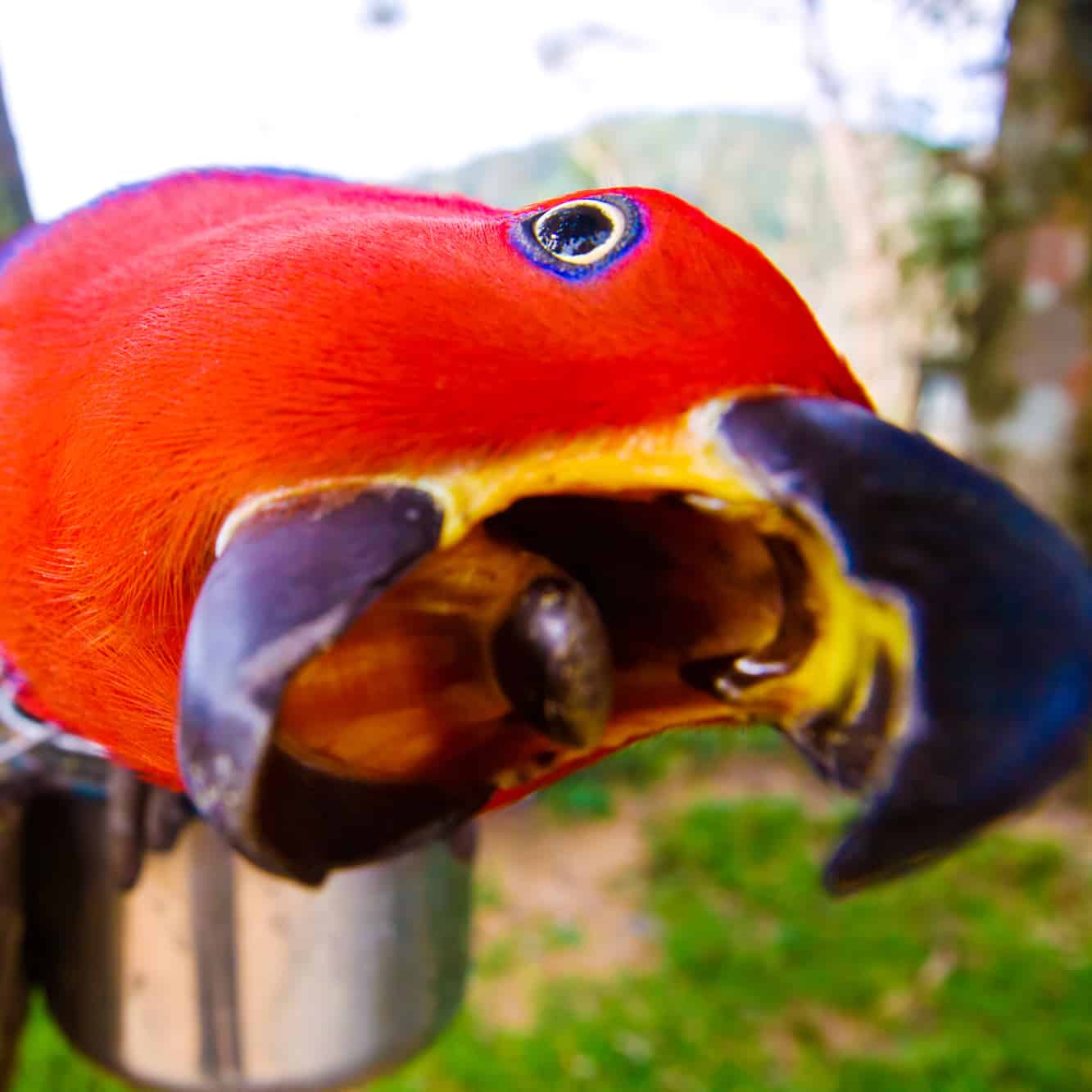Last Updated on by Mitch Rezman
Elucidating Parrot Problems Posted in Aug 2017
How can I make a constantly loud parrot permanently silent (or at least quieter)? from Quora
With between 300 and 400 species of parrots across the planet to say they are ALL noisy is patently untrue.
Poicephalus parrots are not noisy, Senegals, Red bellies, Meyers, Niam niams, brown necked, grey-headed Rueppell’s, and cape parrots. Nine subspecies from the continent of Africa including Yellow-faced parrots who can be squawky but you rarely if ever see them as pets.
Our female cockatiel whistled but that was quite pleasant.
Our ringneck had a 20 – 30 word vocabulary and he was funny when he spoke.
Many people say cockatoos are noisy but which ones? There are 30 species of Cockatoos. Major Mitchell cockatoos are not noisy nor are bare-eyed, some black cockatoos drum on their perches more than vocalize.
Birds are not noisy so they can call out over long distances, they’re noisy so they can call out over each other in a flock. In Australia, hundreds of thousands of budgies will reside in a single flock and they send out search parties for grazing areas and water.
The search parties return and are able to communicate to the flock where to move next to eat and perhaps rest.
As for making a parrot quiet, there are many things that you can do including re-directions, coming to an agreement over daily “scream time”.
As for not being able to “make” birds or animals do anything, that’s preposterous. Humans have long been training animals and have been involved with animals be they horses, Falcons going back to the time of Genghis Khan or the great Barnum & Bailey Circus which had hundreds of trained animals.
We in the US might all be speaking German today if it were not for the 500,000 homing pigeons that were trained during World War II to deliver messages from behind enemy lines.
So once again, all the self-righteous bird companion finger-pointers saying that “we are the only ones allowed to keep birds all the rest of you are incompetent nincompoops!”
Riddle me this? Who is a bird person? Is it a part of my DNA? How do I know if I am not a bird person?
Is someone on Quora keeping track and sending emails reminding people that they are not bird people and don’t even ever TRY to maintain a Bird?
No one in the thread suggested training of any sort. Clicker training – flight training.
What does flight training have to do with screaming? The same thing it has to do with reducing hormonal behavior.
Flying makes the bird tired and thus less prone to scream and act hormonal because they are tired from flying.
Our Senegal parrot who spent 7 1/2 years in a cage 22 hours a day (in a rescue) with clipped wings, flies 10 feet, 5 – 10 times a day, like or not. Trust me Peaches is no screamer.
Every time somebody tells me “My bird is un-trainable” or “You can’t “make” a parrot do anything,” I share this video.
Mitch love your blog posts every week! I have a question I hope you can help with.
I am building out a new bird room that has near-zero natural light. I want to use the proper ceiling fixtures and bulbs for maximum benefit. What would you suggest?
The room is approx 15′ x 15′ and I would like to incorporate ceiling fixtures. My bird is out of her cage all day and spends time all over the house and outside, weather permitting, however, want to create a safe and special place for her to play! Your thoughts are appreciated!
Hi Julia
Thank you for the kind words
Due to a law of physics called the inverse square law of light (see attached), for a bird to get any benefit from lighting, the fixture should be no more than six inches one foot over the cage.
So in your case, perhaps you can install one main ceiling fixture
no ceiling fans we call them shredded tweet
and a hanging fixture or two, be they single lamps or fluorescent tube fixtures.
The hanging fixture(s) should be 6 inch to 12 inh above the cage
I would then advocate timers on at least the hanging lamp(s) set to 12 hours on and 12 hours off helping stabilize your bird’s circadian rhythms.
Bulbs should be at least 100 watts (by incandescent standards) not necessarily have to provide uva and uvb.
Please reach out with further questions
Male cockatiel attacked the female and drew blood so I separated them, but now the female laid an egg and I’m afraid of putting him back in?
Catherine replied
Don’t put them back together in the same cage yet. The hen does not need the male pestering her. She may continue to lay eggs without him. You can remove the eggs as they are laid. If you think they may be fertile (saw the bird’s mate) and want her to hatch them then you will need to get a cockatiel nest box for her.
You then can put the egg inside the box on some pine shavings or ripped-up paper towels.
She may or may not go in after them, she may or may not sit on them, and she may or may not take care of the eggs or after hatching the babies.
If the eggs don’t hatch in the nest box with the mother after 3-4 weeks they are infertile and can be discarded.
Are they a young couple or an older pair?
How large is their cage together? It needs to be at least 24″ wide preferably wider. A small cage will contribute to bickering between couples.
Please reach out with further questions
MitchR
Author Profile
Latest entries
 The Traveling BirdJune 26, 2025Can You Name 5 Parrot Species That Are Living Wild in the USA?
The Traveling BirdJune 26, 2025Can You Name 5 Parrot Species That Are Living Wild in the USA? Bird BehaviorJune 26, 2025How is it Parrots Are Problem Solvers Social Animals and Even Use Tools?
Bird BehaviorJune 26, 2025How is it Parrots Are Problem Solvers Social Animals and Even Use Tools? Bird & Parrot AnatomyJune 25, 2025How a Tiny Chemical Modification Makes Parrots Nature’s Living Paintings
Bird & Parrot AnatomyJune 25, 2025How a Tiny Chemical Modification Makes Parrots Nature’s Living Paintings PigeonsJune 20, 2025How Do Parrots Thrive in Cities Outside Their Native Habitats?
PigeonsJune 20, 2025How Do Parrots Thrive in Cities Outside Their Native Habitats?





Diana Gross
27 Aug 2017I would not recommend removing eggs as laid. Cockatiels will continue to lay and can deplete their body of calcium. Leave the eggs or replace with dummy eggs until she no longer shows any interest in them.
WindyCityParrot
27 Aug 2017Hi Diana
We strongly advocate the removal of eggs as it only makes the bird want to brood more. we shut down egg laying with light therapy to short circuit the birds circadian rhythms – it works with no guesswork and is veterinarian recommended.
Diana Gross
27 Aug 2017I would not recommend removing eggs as laid. Cockatiels will continue to lay and can deplete their body of calcium. Leave the eggs or replace with dummy eggs until she no longer shows any interest in them.
WindyCityParrot
27 Aug 2017Hi Diana
We strongly advocate the removal of eggs as it only makes the bird want to brood more. we shut down egg laying with light therapy to short circuit the birds circadian rhythms – it works with no guesswork and is veterinarian recommended.
SHAIL SHARMA
8 Sep 2017Parrots are beautiful!
Find the world’s top 10 beauiful parrots here –
https://blindetop10.wixsite.com/home/single-post/2017/09/08/Top-10-Most-Beautiful-Parrots-1
SHAIL SHARMA
8 Sep 2017Parrots are beautiful!
Find the world’s top 10 beauiful parrots here –
https://blindetop10.wixsite.com/home/single-post/2017/09/08/Top-10-Most-Beautiful-Parrots-1